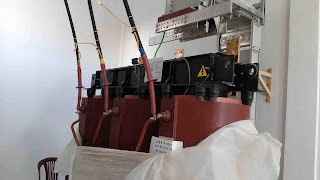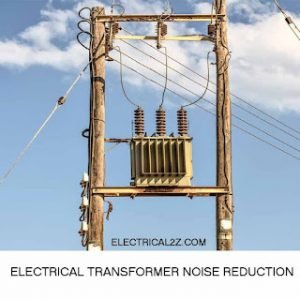One of the passive electrical device is the electrical transformer. It is used to transfer the electrical energy. In this article we are going to see about maintenance of transformer. The guide is completely covered about transformer maintenance. So, read carefully without skip any paragraph.
Table of Contents
Precautions For Paralleling Transformer
The following precaution should be taken:
(i) Study the nameplate particulars, voltage ratio, percentage impedance, vector diagram and group number, terminal marking etc. and make sure that all conditions for parallel operation are fulfilled. If the name plate or terminal marking is missing a much more elaborate procedure is required i.e. the transformer windings have to be lifted out and the external connections traced and identified, if necessary.
(ii) Even when everything seems right, it is still advisable to observe a definite testing procedure as any erroneous connection may result in a short circuit. Do not forget to connect the transformer tank body solidly to earth.
(iii) For conducting a phasing out test, it is not necessary to apply the rated voltage side. A much lower voltage is more convenient. For example, a 6.6 kV/ 400 V transformers primary cloud be connected to a 400 volt supply. The secondary voltage will be corresponding lower i.e. about 24 volts which make it much safer and easy to work with.
(iv) If full rated voltage has to be applied, it will be necessary to use potential transformers. The terminal markings and polarity of the potential transformers also will have to be checked. Remember the possibility of 1800 phase difference if the connections are not correctly made to lie terminals.
(v) It is necessary to link up the two secondary by one common connection, so that voltmeter readings may be taken. If the secondary star connected and the neutrals are available, no neutral is available and the secondary leads of the two transformers are completely isolated, connect any terminal of one transformer of what appears as the corresponding terminal of the other transformer. Even if it is connected to the wrong terminal, no harm is done and the tests will reveal the error.
(vi) In using a voltmeter for the test, a fundamental precaution to be taken is to put its range switch to a much higher scale before carrying the test, i.e. at least twice the excepted voltage. If the secondary voltage is 400 V, the voltmeter range switch should be set to 1000 V, for the first set of measurements. After the terminals are identified and the corresponding terminals show little or no voltage, the selector switch should be put to a lower scale say 0-50 volts or less to make an accurate measurement of the voltage different between corresponding terminals. This should be negligible.
Inrush Current and Its Remedy
When a transformer is switched off the line, the primary circuits open at zero current, but the secondary current takes a sort time to decay to zero. This leaves a residual flux in the core of the transformer. It is a fundamental principle of the transformer that the voltage applied to the primary is nearly counterbalanced by the back e.m.f produced by the alternating magnetic flux in the core.
At the instant of switching in a transformer the back e.m.f which develops is dependent upon the value of the residual flux which may either be in opposition to the flux produced by the impressed voltage as it should be, are it may be as assisting it.
Therefore at the instant of switching in the current flow is determined by the value and direction of the back e.m.f. and, therefore, upon the residual flux in the core at the time. Under the worst condition, this current is limited only by the air core reactance of the windings since the core would be saturated and its impedance is greatly reduced.
The current inrush would be as high as five times full load current and persist for as long as two seconds. Since the current flows only through the primary winding of the transformer and there is no corresponding outflow on the secondary side, it has the same effect as an internal fault as the differential relay is concerned.
This unavoidable current such at the time of switching in a transformer has always been a source of difficulty especially with high speed differential relays the inrush current is essentially a pulsating direct current which rapidly decays. It contains a large percentage of harmonic components. This fact is utilized to block the operation of the differential relay during the current inrush period by providing restraining coils (RC) and harmonic restraint, comprising series and parallel tuned filter circuits (TF). To make the differential relay inoperative during the current inrush, but leaving unimpaired its ability to act instantly for false within the transformers.
Insulation Co-ordination
A grid network comprising extensive overhead transmission lines, switch gear and transformer is subject to over voltages which may cause by external atmospheric sources such as lightning discharges, or internally produced surges due to switching operations or faults. When such voltage disturbances occur, it is naturally the weakest link in the system which breaks down. In the interest of continuity of supply it is obviously necessary to protect the system against such over voltages by the installation of lightning arresters or spark gaps whose characteristics should be such as to bypass the surge safely to earth.
The breakdown voltage of the arrester should be carefully chosen: it should be appreciably lower than that of the overhead line insulators, switch gears or the transformers, but much higher than the normal operating voltage.
It is, therefore, necessary to co-ordinate and grade the insulation level of the various components parts of a system intelligently, the principle being that the greater the cost of an equipment and the more its vulnerability the higher should be it’s insulation level to reduce the risk of failure. Thus, in a grid network, the surge diverters should have the lowest insulation level(Figure ), followed by suspension insulators, isolating switches, circuit breakers and finally the transformer which should have the highest level since they are costliest.
The expression ‘insulation co-ordination’ refers to the steps taken to correlate the insulating strength of the different electrical apparatus to prevent their being damaged by over-voltages and to localize flashovers and thereby achieving reliability of supply.
Effect On Insulation During Start Point Earthing
In the three phases UN earthed system fig. if one leg say C gets earthed, the other two lines A and B will be at a potential equal to full line voltage above the ground. Therefore the protective devices including lightning arrestors should be based on full rated line to line voltage, with respect to earth. In a three phase system containing a star winding, whose neutral point is connected to a perfect earth.
One having no earth resistance, the lines A and B will theoretically remain at a potential equal to 1/ 3of the line voltage above earth, if line C is earthed, 57.6 percent of the normal value. In practice, however, the earth connection will necessarily have some resistance which will raise the potential of the neutral, when line c is earthed, because of IR drop in the earth resistance.
The effect of this is that all insulators on the line A and B will be subjected to a potential which is somewhere between 57.6 percent of full line voltage as in a perfectly earthed system. And a maximum of line-to-line voltage as in the unearthed system. Thus earthing has a direct bearing on the insulation level, and is taken care of by what is called ‘co-efficient of earthing’. The system which is considered as effectively earthed if the co-efficient of earthing is 80 percent. The insulation level is always with respect to earth, although it is indicated against the three phase line-to-line voltage.
Schedule: Maintenance of Transformer
The transformer is one of the most reliable items of electrical equipment, requiring relatively little attention; yet often even this minimum of attention is not given, and no wonders they do sometimes breakdown because of neglect.
The programmed of inspection and maintenance is governed by the size of the transformer, where it is installed, whether indoors or outdoors, if in a substation is it manned or unattended, the operating conditions and so on. The degree of attention required depends greatly upon how heavily or lightly the transformer is loaded the maintenance schedule in table 1. Covers oil immersed, naturally-cooled transformers of three categories.
1. Major installations at large grid substations which are manned all the time, with unit size of 1000 to 10000 KVA or more. Quite often the transformer loading is quite high.
2. Medium installation in small substations with unit capacities of 250 KVA to 1000 KVA.
3. Minor installation up to 250 KVA unit capacity which are unattended and often at remote points, such as pole mounted transformers, and rural distribution transformers.
The interval of inspection are indicated as; H for hourly, D for daily, W for weekly, M for monthly, 3-M & 6-M for 3 monthly and 6 monthly, Y for yearly, 2-Y for, 5-Y for, 2yearly and 5 yearly.
In major and medium installations a stand by transformers should always be available to be switched on at a moment’s notice, in place of the largest unit installed. It should be maintained to the same standards as the other units, and periodically put to use to keep it in a good and healthy condition.
In major installations, using year blast cooling or water cooling, a daily check should be made of the ancillary installations like air blowers, water pumps and the connected protective devices, on load tape changes etc.
Maintenance of Transformer
 |
| maintenance of transformer |
Action To Be Taken While Transformer Oil Temperature Rises Unduly
In every large well regulated system, a close watch is always maintained of the loading conditions, and the oil temperature. Excessive oil temperature is the result of overloading. This should not be permitted to occur, by taking timely action to switch on a larger unit for operation or to put another unit in parallel to share the load. Remember, excessive temperature reduces life and therefore, if oil temperature rises unduly for any reason the transformer should be put out of service immediately, but the cooling fans. If any, should continue to run until the oil temperature falls to normal.
Points To Be Checked By Oil Level Tends To Fall Down
Transformer oil may leak at several points, i.e. oil level gauge, cork packing below the top cover, oil conservator, connection, drain cock, gasket, bolt where a cablebox is bolted in, and welded joints. Every oil leak should be traced to its source and remedial action taken to stop the leak. If the gasket leak cannot be stopped by tightening the bolts, the gasket should be renewed.
The belt material for gasket is cork, rubber sheet 5mm thick. This consists of fine granulated cork and synthetic rubber as the binding medium. The surfaces between which the gasket is provided should be quite flat and smooth without any burrs or irregularities.
They should be perfectly clean and free from scale, rust, old paint, remains of glue and old gasket, grease or oil. The surface should be thoroughly cleaned and washed with trichloroethylene, alcohol or other gases solvent. If it is glossy surface such as backlite, it should be made rough by emery cloth or sand paper. The gasket should preferably made slightly narrow than the flange width so that it may not swell beyond the edge when compressed. Though the cascade makes good oil tight a joint, it is an advantage if the gasket joint surface is coated with a thin layer of special glue obtainable from the manufacturers.
Inspection covers, which may require to be opened whenever required, may be coated with ball- bearings grease over the surface which comes in contact with the gasket. The cover can then be opened without damaging the gasket.
Care should be taken to tighten the bolts uniformly going from one bolt top the next, over the entire lot several times so that the surface pressure is uniform all over. The compression should be limited to 2/3 of original thickness. The retightening operation should be repeated sometimes after the transformer is put into use, as the gasket tends to settle down after sometime. This should be done, say two days after renewing the gasket, and again a week later the bolt lighteners should also rechecked during a six monthly inspection.
Sometimes slight oil leakage occurs at the welded joints the exact point of the leakage outside the tank can be discovered first by cleaning the surface thoroughly with a grease solvent or petrol or denatured alcohol, and then coating the surface with a thin layer of chalk, cement plate in water or white wash and allowing it to dry. Leakage of oil is then readily revealed by the dark patch it forms.
As for the cure much depends upon how bad the leak is. Formation of a few drops over a period of time is not of any consequence and occurs in most transformers. If it is bad, cracked or spongy well may be repaired by welding in a metal patch. A small hole in the weld can often be put right by peeping with a cold blunt chisel until the hole is closed, and then finally using a ball peen hammer to complete the seal.
Special solders which have a great affinity for iron but which are unaffected by oil could also be used to stop oil leaks through porous weld threaded bolt fixtures, internal welds making use of a blow torch; take care to guard against any explosions. If a hole exists in a casting it may be drilled and a tight brass plug driven in. it is no use using shellac as a filter as shrinks considerably when it dries. After completing the repairs, the deficiency in oil level should be made good and a careful note made of the oil level for verification at the next inspection.
Attention Is Required On Bushings And Insulators
It is essential to examine porcelain bushing and other insulators, such as busbar supporting insulators and surge-diverter at frequent intervals. The porcelain surface should be thoroughly cleaned with a wet cloth and polished, after removing every trace of oil or dust. In most insulator urban areas there is heavy atmospheric pollution, and fine dust, soot, and industrial deposit settle down on the insulator skirts. If not removed at frequent intervals they tend to form a very hard curst.
When dew or moisture appears on the insulator, the combinations make a conducting path which could easily result in a flashover. Very often, the heat produced by the leakage path damages the glazed surface of the insulators. The position is aggravated is coastal areas subject to salt deposition. In U.K. extensive failures have occurred when snow deposition on insulators starts melting in early spring and eases up the dirty deposit of soot, salt and dust.
Extensive research has been made as to the methods of overcoming the trouble. One of the principles employed is to apply a water repellent on the porcelain surface such as thin coat silicone grease. Dust and coil will no doubt stick to the surface and the insulator may present a very dirty appearance, but the function of the insulator remains unimpaired, as the oil or grease engulfs the contaminants and insulator one particle from the other, inhibiting and tendency of from leakage path. It is of course necessary to point is reached, and to apply a fresh coat of thin grease.
Another method employed for live-line cleaning, at substation which cannot be shut down, is to wash the insulators by directing a high-pressure finely atomized water spray, using high resistivity water and maintaining safe distances. In India, none of these procedures appear to be called for. Hand cleaning by wiping off the deposits with a wet or petrol soaked cloth will be found to be fully efficacious it the glazed surface is finally polished with a dry cloth.
When polishing, the bushing surface should be carefully examined for hair-line cracks; when the transformer is put on load, the crack may develop rapidly to dangerous dimension. At the same time it is as well to go over all current-carrying parts with a spanner gently but firmly, to ensure good contact. Remember that a poor contact will develop enormous heat when in operation, which may ultimately cause a burnout or crack the insulators.
Final Word
Hope you understand this article about the Maintenance of Transformer. Incase of any doubt please comment below. Subscribe our website to get every new post update to your email. Please follow our website @ElectricianWorld.Net for future updates. Thank you for visiting our website.




HERING VPT is one of the world’s leading manufacturers of transformer oil purification machines, transformer oil regeneration systems, waste oil re-refining systems and vacuum drying chambers